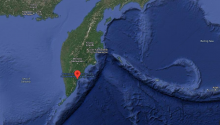Sorry if it seem stupid, I'm asking because I don't know.
I understand that convoys and resupply ships will have specific routes, that will be patrolled regularly by ASW planes and ships. But can't submarines just hit convoys, then sail back out into the expanse of the ocean and sit quietly and then hit again, or return to base? What am I missing?
There is a vast expanse of the Pacific Ocean between CONUS/Hawaii and the SIC.
Getting past the island chains with useful payload and underwater endurance/speed means it has to be an SSN and those are quite expensive. Even the US with its budget only has 68 active (according to Wiki). They'll need to past through SOSUS-like networks throughout the island chains to get to these convoys too.
The US managed to sink 1392 Japanese ships over 1474 war patrols through the entire WW2 period. That was about half of the Japanese pre-war capacity. But this happened in an environment where the Japanese seldom ran escorts/convoys and had subpar ASW. The US also had 288 submarines to conduct these interdiction missions with. So in a situation with vastly more submarines and almost no opposition, the US only sank 1392 out of what was likely 3000 ships total pre-war. These numbers don't include ships below 500 tons which would be fishing trawlers and the like.
Germany had a difference of 55kton (convoy) vs 350kton (unescorted) in sunk tonnage from before the fall of France and after the fall of France. The fall of France enabled Germany to bypass detection in the Channel / north of the UK and venture into the Altantic and target the unescorted ships. So if we assume naively that a somewhat similar ratio holds, if the Japanese were able to escort their ships and form a convoy system, the US might have only sunk some 220 ships which would have been less than 1 ship per submarine in the fleet.
For reference, Panama canal sees about 14,000 ships per year and Malacca Straits sees about 100,000 per year nowadays. Then there's also the ships that don't need to pass through those straits (China-Japan, China-US, etc. etc.) as well as the smaller ships that can still carry a useful load. If the US is able to enlist a sizeable fraction of it or it's ally affiliated MM to transport, that's going to be too many targets for a small SSN fleet. It's not like most of those shipping companies won't be dying for government money (and so enlist) when global trade collapses due to a Sino-American war. We also don't expect the main effort of such a war (mainly air/naval) to last multiple years.
To be clear, I don't expect those ratios etc. to be the same in a modern war. But it shows a useful reference of what sort of scale is necessary to make a significant impact.
In short, the submarines can sink supply ships, but I don't think it'll have a significant impact on the war due to the scale of the shipping involved. It would be more useful to use the limited number of submarines to expend their payloads on things like the fixed aggregation sites: ports, depots, airfields, factories, etc.
Last edited:

